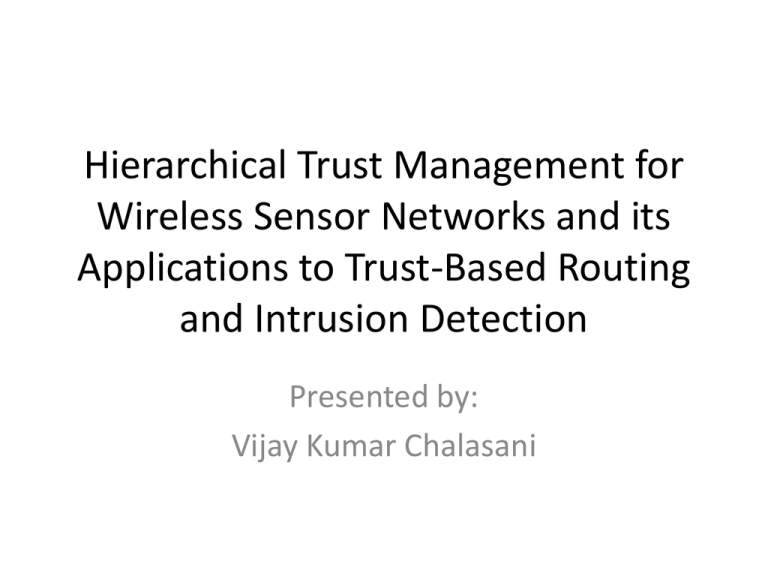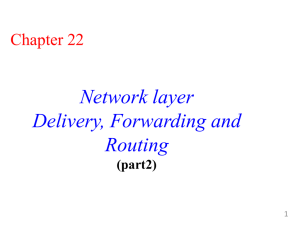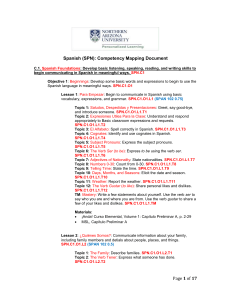Bao-TNSM12-slide
advertisement

Hierarchical Trust Management for
Wireless Sensor Networks and its
Applications to Trust-Based Routing
and Intrusion Detection
Presented by:
Vijay Kumar Chalasani
Introduction
o This paper proposes “hierarchical trust
management protocol”
o Key design issues
• Trust composition
• Trust aggregation
• Trust formation
o Highlights of the scheme
• Considers QoS trust and social trust
• Dynamic learning
• Validation of objective trust against subjective
trust
• Application level trust management
System Model
o Cluster based WSN (wireless sensor network)
o SN CH base station or sink or destination
o Two level hierarchy
• SN level
• CH level
o At SN level
• Periodic peer to peer trust evaluation with an
interval Δt
• Send SNi-SNj trust evaluation result to CH
System Model
o At CH level
• Send CHi-CHj trust evaluation result to base station
• Evaluate CH – SN trust towards all SNs in the cluster
o Trust metric
• Social trust : intimacy, honesty, privacy, centrality,
connectivity
• QoS trust : competence, cooperativeness, reliability,
task completion capability, etc.
o In this paper, intimacy and honesty are chosen to
measure social trust. Energy and unselfishness
are chosen to measure QoS trust.
Hierarchical Trust Management
Protocol
o Two levels of trust : SN level and CH level
o Evaluations through
• Direct observations
• Indirect observations
o Trust components : intimacy, honesty, energy,
and unselfishness
Tij = w1Tijintimacy (t) + w2Tijhonesty (t)
+w3Tijenergy (t) + w4Tijunselfishness (t)
w1+w2+w3+w4 = 1
Hierarchical Trust Management
Protocol (cont.)
o Peer to Peer Trust evaluation
• For 1-hop neighbors
TijX (t)= (1-α) TijX (t- Δt) + α TijX,direct
= trust based on past experiences + new
trust based on direct observations
(0 ≤ α ≤ 1) (decay of trust)
• Otherwise
TijX = avgk∈Ni {(1-ϒ) TijX (t- Δt) + ϒTkjX,recom (t) }
Obtaining trust component value
TijX,direct for 1-hop neighbors
o Tijintimacy, direct (t) :
• Ratio of # of interactions between i and j in (0, t) &
# of interactions between i and any other node in
(0, t)
o Tijhonesty, direct (t) :
• Measured based on count of suspicious dishonest
experiences
• ‘0’ when node j is dishonest
• 1-ratio of count to threshold
Obtaining trust component value
TijX,direct for 1-hop neighbors
o Tijenergy, direct (t) :
• By keeping track of j’s remaining energy
o Tijunselfishness, direct (t) :
• By keeping track of j’s selfish behaviour
Obtaining trust component values for
the nodes that are not 1-hop
neighbors
o TijX (t)=avgk∈Ni {(1-ϒ) TijX (t- Δt) + ϒTkjX,recom (t) }
• Past experiences + recommendations of 1-hop
neighbors
βTik
(t)
• ϒ=
………..trust decay over time
1+βTik (t)
• Tik (t) is node i’s trust over k as recommender
• β ≥ 0 , specifies the impact of indirect
recommendations
Trust Evaluations
o CH to SN trust evaluation:
• If Tcj (t) less than Tth , then node j is compromised
else j is not compromised
• CH also determines from whom to take trust
recommendations
o Station to CH trust evaluation:
• Same fashion as of the above evaluation
Performance Model
o Probability model based on SPN
• Obtain objective trust
o ENERGY
• Indicates the remaining energy level
Energy
T_ENERGY
• Rate of transition T_ENERGY is energy
consumption rate
Performance Model
o Selfishness
SN
T_SELFISH
P selfish =
𝐸𝑐𝑜𝑛𝑠𝑢𝑚𝑒𝑑
µ
𝐸𝑖𝑛𝑖𝑡
T_REDEMP
+ (1- µ)
𝑁𝑛𝑒𝑖𝑔ℎ𝑏𝑜𝑟 𝑢𝑛𝑠𝑒𝑙𝑓𝑖𝑠ℎ
𝑁𝑛𝑒𝑖𝑔ℎ𝑏𝑜𝑟
• Transition rates
T_SELFISH = P selfish / Δt
T_REDEMP = (1 - P selfish ) / Δt
Performance Model
o Compromise
CN
T_COMPRO
DCN
T_IDS
o rate of T_COMPRO , λ = λc-init (#compromised
1-hop neighbors/#uncompromised 1-hop
neighbors)
Subjective trust evaluation
o TijX,direct (t) is close to actual status of node j at time
t
o Tijhonesty,direct (t):
• Status value of ‘0’ if j is compromised in that state.
Else ‘1’
o Tijenergy,direct(t) :
•
Status value of Energy/Einit
o Tijunselfishness,direct(t) :
•
Status value of ‘0’ if j is selfish in that state. Else ‘1’
Subjective Trust evaluation
o Tijintimacy,direct(t) :
•
•
•
•
Is not directly available from state representations
Calculated based on interactions like : Requesting,
Reply, Selection, Overhearing
If a, b, c are average # interactions with selfish node,
compromised node , normal node respectively
a = 25% * 50% *3 + 25% *2 + 25% *2
b = 0 + 25% *2
c = 25% *3 + 25% *2
Status value a/c is given to states in which j is selfish.
status value b/c is given to states in which j is
compromised and c/c (1) to states where j is normal
Objective trust evaluation
o Objective trust is computed based on the
actual status as provided by the SPN model
Tj,obj(t) = w1Tj,objintimacy (t) + w2Tj,objhonesty (t)
+w3Tj,objenergy (t) + w4Tj,objunselfishness (t)
o The objective trust components reflect node
j’s ground truth status at time t
Trust Evaluation Results
o Here, graph is plotted for X
= intimacy
o As α increases, sbj trust
approaches obj trust
initially. But deviates after
cross over
o As β increases, sbj trust
approaches obj trust
initially. But deviates more
after cross over
o best α, β values depend on
nature of each trust
property and given set of
parameter values.
Trust Based Geographic Routing
o Geographic Routing: A node disseminates a
message to L neighbors closest to the
destination
o In trust based Geographic routing, not only
closeness but also trust values are taken into
account
Trust Based Geographic Routing
o Assuming weights
assigned to social trust
properties are same
(similar assumption to
Qos trust)
o Balance between Wsocial
& WQoS
o It can dynamically
adjust Wsocial to optimize
application
performance
Trust Based Geographic Routing:
performance comparison
o Delay increases with
increase of compromised
nodes
o Message delay in GR is
less than Message delay
in Trust based GR
o Trust base GR has more
message overhead as
compared to traditional
GR
o # messages propagated =
3 when compromised or
selfish nodes are >80%
Trust Based Intrusion Detection
o Based on the idea of minimum trust threshold
o CH evaluates a SN with the help of trust
evaluations received from the other SNs
o Considering trust value towards node j a
random variable
𝑇𝑖𝑗(𝑡) − µj(t)
𝑥𝑗(𝑡) =
𝑆𝑗(𝑡)/ 𝑛
(n sample values of Tij(t) are provided by n SNs)
𝑇𝑖𝑗(𝑡) , 𝑆𝑗(𝑡), and µj(t) are sample mean, sample
standard deviation, and true mean respectively
Trust Based Intrusion Detection
Prob of j being diagnosed as
compromised
Θj(t) = Pr(µj(t) < Tth)
𝑇𝑖𝑗 (𝑡) − 𝑇𝑡ℎ
= Pr(𝑥𝑗 𝑡 > 𝑆 (𝑡)/ 𝑛 )
𝑗
False negative prob:
Pjfn
= Pr(𝑥𝑗 𝑡 >
𝑇𝑖𝑗(𝑡) − 𝑇𝑡ℎ
)
𝑆𝑗𝑁(𝑡)/ 𝑛
False positive prob:
Pjfp
= Pr(𝑥𝑗 𝑡 ≤
𝑇𝑖𝑗(𝑡) − 𝑇𝑡ℎ
)
𝑆𝑗𝐶 (𝑡)/ 𝑛
Average values over time:
𝑆𝐿
𝑓𝑝
𝑡 (1−𝑃𝑗𝐶 𝑡 )
𝑡=0(𝑃𝑗
fp
Pj =
𝑆𝐿 (1−𝑃𝑗𝐶 𝑡 )
𝑡=0
𝑆𝐿
𝑓𝑛
𝑡 (1−𝑃𝑗𝐶 𝑡 )
𝑡=0(𝑃𝑗
fn
Pj =
𝑆𝐿 (𝑃𝑗𝐶 𝑡 )
𝑡=0
Trust Based Intrusion Detection:
Comparisons
Conclusion
o Approach considered two aspects of
trustworthiness : Social and QoS
o Made use of SPN to analyze and validate
protocol performance
o Comparisons are made with other techniques









